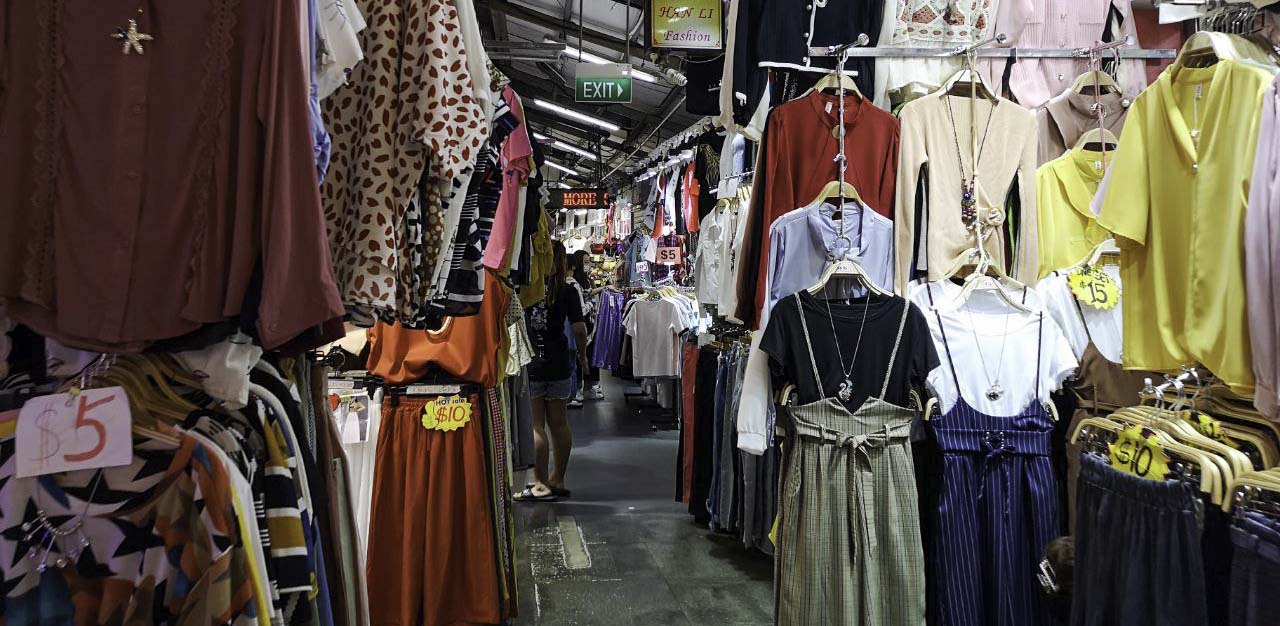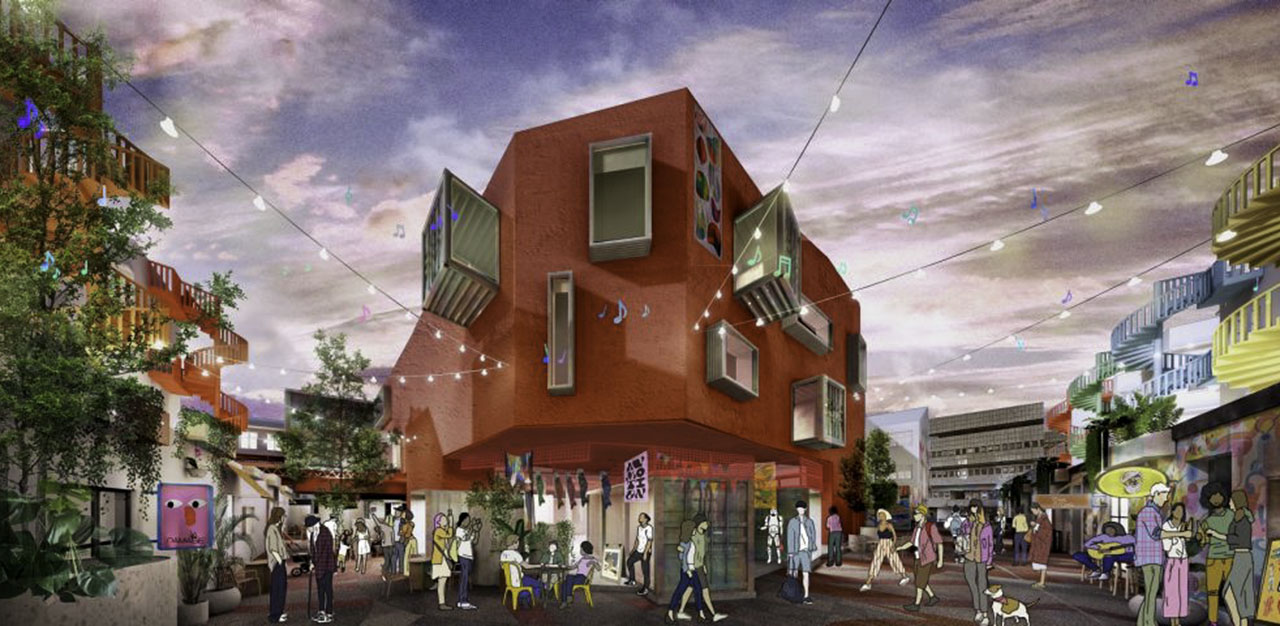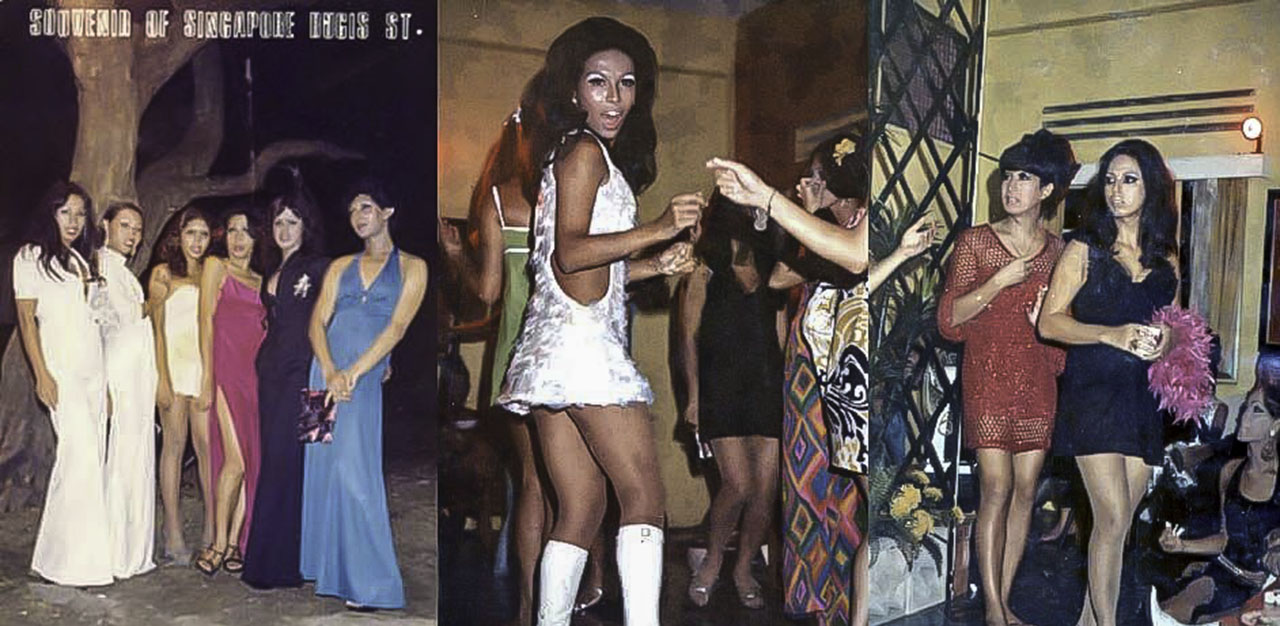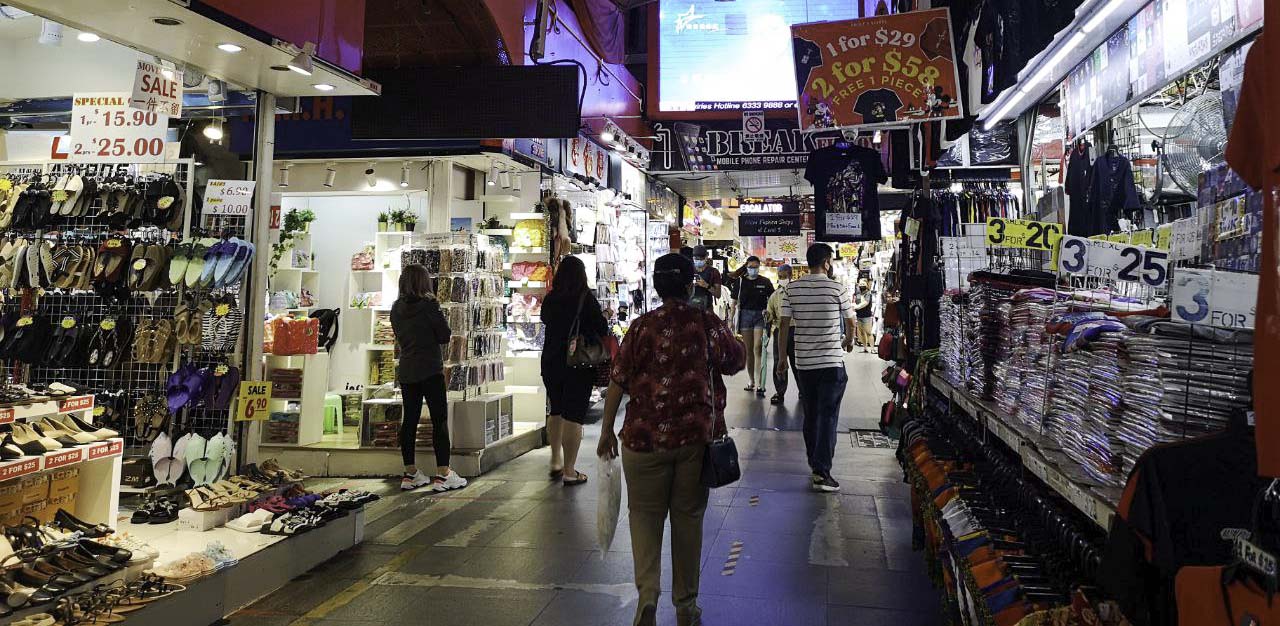One might be forgiven for thinking that the Bugis Street as we know it was already gone if you looked at Fazleen Karlan’s artwork, Hanya Tinggal Kenangan (Only Memories Remain), which the artist had created in response to the news of the changeover in Bugis Village and Bugis Street management last year.
In this artwork, she encased items found from the old shopping belt in clear acrylic vitrines, as though they were rubble excavated from an archaeological site. Orange mesh fencing wrapped around the two pillars surrounding the work, invoking the sense of being in a construction site. Although the labyrinthine shopping arcade is still very much well and alive (for now), the artist seems ready to say her goodbyes.

“Bugis Street was the place to go to experiment and find out the kind of ways that you would like to present yourself to the world through your clothing and accessories. And it was also a place to get souvenirs, I mean, seeing that it’s quite a touristy spot,” Fazleen muses, perhaps unconsciously using the past tense when referencing the shopping bazaar, “It was quite a rojak place to be honest, a bit chaotic, you know?”
An icon of millennial youthhood
The 27-year-old archaeology technician and artist fondly recalls the many hours that she and her friends had spent shopping in the area, especially before celebrations such as Hari Raya. She sees the shopping belt as a site that was formative of her youthhood. It’s a sentiment that many millennials might share – during its heyday in a pre-Taobao era, it had been one of the best places to find bargain street fashion.
Ian Kong, content strategist, shares, “My earliest memory of Bugis Street had to be shopping for clothes and accessories on a dime. Vain and fresh in our teens, it was the era of early 2000s music and my friends and I wanted to emulate our favourite musicians and bands. We knew we could find cheap, decent quality options in every nook and cranny – with the irrational belief that the longer we went around the maze-like aisles, the better the deals we would find. And when we got hungry, food stalls were aplenty and snacks easy to wolf down.”
Today, the once-bustling indoor shopping market is still filled to the brim with trendy street clothing, kitschy souvenirs and cheap bags and accessories. But the absence of the throngs of tourists that once frequented the area means that it’s now a bit of a ghost town. A number of storefronts are shuttered – likely casualties of the ongoing pandemic.
When asked how business has been, one storekeeper gruffly replies, “Just walk around and you’ll see.” He rues, “Those who are here are just passing time, they don’t really buy.”

Bracing for winds of change
It has not been an easy year for retail businesses in general, and this holds true for the storeowners of Bugis Street. Storekeepers that THG spoke to unanimously remark that sales have been bad ever since the advent of the pandemic, since the travel restrictions meant that the tourists that were the lifeblood of the shopping belt are scarce.
Some of the old-timers also attributed the decline in sales to the burgeoning online marketplace, where people could easily source for similar goods at better prices on sites such as Taobao, Shopee and Lazada.
CapitaLand has declined to comment on the topic of rent but one storeowner whom THG spoke to on the condition of anonymity shared that the impending changes of lease terms would include a Gross Turnover component, whereby tenants would be obliged to pay a percentage of their monthly sales to the landlord in addition to the fixed monthly rental sum. This, she felt, would amount to a general increase in rent at a time when tenants were already haemorrhaging from the poor sales of the past year.
Taken together, these factors have got her considering giving up her store space in Bugis Street and taking the business online, but it’s a decision that she’s still mulling over.
Say hello to Bugis Town
Meanwhile, CapitaLand intends to consolidate the properties that it manages in the neighbourhood to create an entity called Bugis Town. The real estate developer owns and manages both Bugis Junction and Bugis+, the two malls closest to Bugis Village and Bugis Street.
“With each mall having its unique positioning, Bugis Town is set to be a vibrant lifestyle destination for both locals and tourists, and benefit from the culturally rich heritage in the Bras Basah Bugis precinct,” says the CapitaLand spokesperson.
However, it is as yet unclear what exactly being a part of Bugis Town will entail for Bugis Village and Bugis Street, except that it will be carried out in phases. The CapitaLand spokesperson declines to confirm whether they intend to go ahead with certain aspects of the initial plans to revamp, such as a “day-to-night market” and a “retail incubator”.

That said, one concept unveiled last year – that of “shared economy spaces such as coliving and coworking areas” seems set to take root in the form of “hovoh”, “a sustainable coliving residence” that “offers residents edible garden starter-kits, work-from-home stations, a wellness corner, contactless housekeeping and communal areas turned into private work-pods”, the spokesperson shares.
Is this just a very roundabout way of saying that they intend to build a condo at Bugis Street? Because if that is the case, then CapitaLand is not alone in the impending gentrification of the Bugis-Bras Basah region. A stone’s throw away at Tan Quee Lan Street, developer GuocoLand recently launched luxury condominium residence Midtown Modern, where units sold at an average price of close to $2,800 psf over the launch weekend.
This new residential project is but one part of GuocoLand’s mammoth integrated development Guoco Midtown, which will occupy a significant 3.2 hectares of the Bugis-Bras Basah neighbourhood when fully built.
Given the many changes afoot in the neighbourhood, one cannot help but wonder how the experience of the space will change for the common folk who cannot afford to reside in and enjoy the futuristic, sustainability-minded innovations of these new developments.
A final nail in the coffin for Bugis’ colourful heritage
A corollary concern is what happens to the public’s collective sense of history when identities once so central to a place are dismantled to make way for the new. Even as it stands, the present-day Bugis Village and Bugis Street hold few traces of its lively history.
In the earlier half of the 19th century, this area had originally been home to the Bugis, a seafaring people originally from the southwestern peninsula of Celebes in Indonesia for whom the neighbourhood was named. Though the Bugis had once been a significant portion of Singapore’s population in the 1820s, all that’s left of their presence in Bugis Street today are a few informational plaques in the air-conditioned pedestrian walkways encircling the Bugis Junction mall.
And how many shoppers know that the area was once a hotspot for Singapore’s transgender community? Back in the 1950s to mid-1980s when Bugis Street had been a popular tourist destination, members of the male-to-female transgender community would make a living entertaining tourists and locals alike in the evenings.

With each successive redevelopment of the neighbourhood, the layers of the place’s past fall away and become forgotten. Our SG Heritage Plan speaks of heritage as “the sum total of our memories, experiences, records, artefacts and traditions that we have inherited from our past,” but it may well be that whatever heritage is invoked in the freshly-rechristened Bugis Town involves that which can be commodified and sold.
In this vein CapitaLand points to Ji Xiang Confectionery, a homegrown ang ku kueh maker whose flagship store has just opened in Bugis Village, as an example of the kind of heritage that shoppers can look forward to while the development is under their management.
Concerns over losing charm, heritage and space for the elderly
Chelsia Low, operations manager, shares her concerns for the older generation for whom this neighbourhood is their home ground, saying, “The way that Bugis is right now, the land use and activities there is very intertwined with all walks of life, from children, to working professionals, to even homemakers and our elderly senior citizens. But I think if it is revamped, the elderly might think that they are going to be the outsiders who will be displaced. So I hope CapitaLand can take this into account in their plans.”
Natalia Tan, educator and artist, says, “There is just no substitute for a night market with all its sights and sounds and smells in the air. I hope people can experience the joys of being out and about in the revamped Bugis Street, and I hope that the developers can also pay tribute to the heritage of the area.”

Time to say goodbye?
Without a clear timeline from the developers as to their plans for Bugis Village and Bugis Street, it is difficult to know how long the place will stay intact in its current form. But between the challenging retail climate for brick-and-mortar stores, the dearth of tourists and what looks to be impending gentrification, the end of Bugis Village and Bugis Street as we know it looks nigh.
So if this grungy, labyrinthine shopping arcade was once your stomping ground, consider visiting and grabbing a souvenir or two while you still can. In this city where the only constant is construction, it might be gone before you know it.












